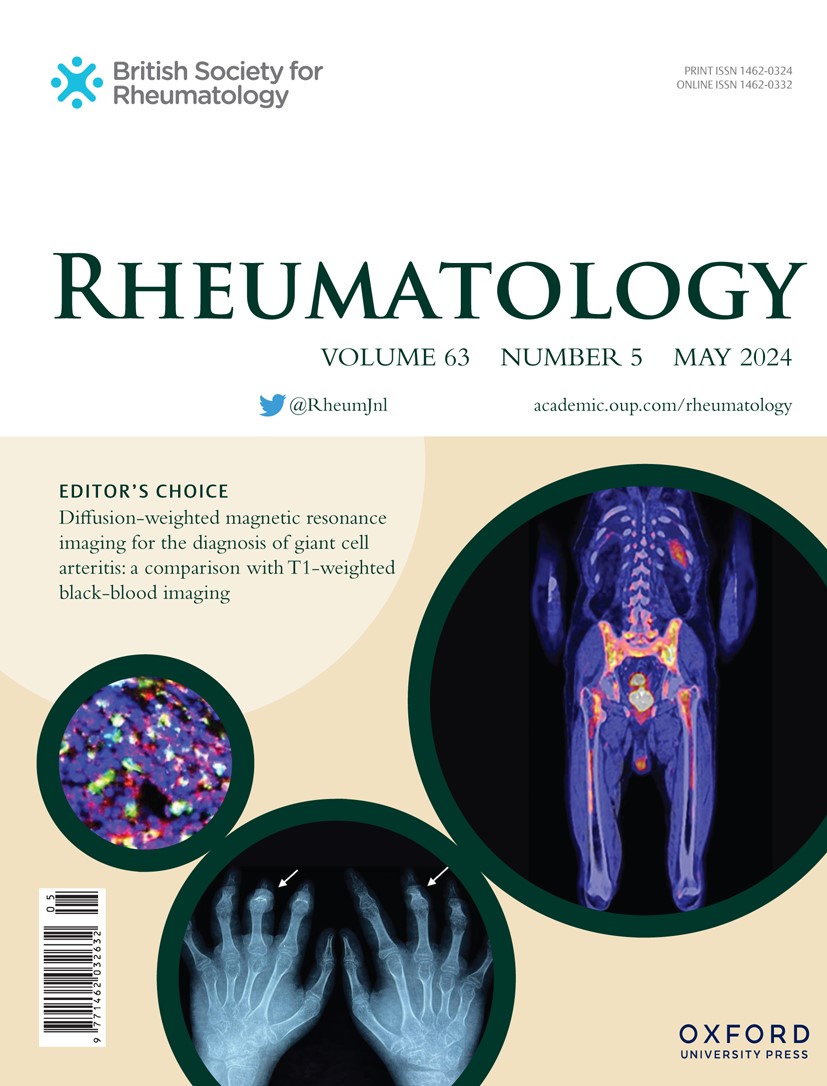靶向PTGDS抑制系统性硬化症皮肤纤维化的促炎成纤维细胞
IF 4.7
2区 医学
Q1 RHEUMATOLOGY
引用次数: 0
摘要
免疫失调显著促进系统性硬化症(SSc)的皮肤纤维化,促炎成纤维细胞在这一过程中起关键作用。前列腺素D2合成酶(PTGDS)由于在与皮肤纤维化相关的促炎成纤维细胞中表达丰富而引起了人们的兴趣。本研究旨在阐明PTGDS在SSc皮肤纤维化中的作用,并评估其作为治疗靶点的潜力。方法采用生物信息学方法对SSc患者皮肤组织中PTGDS的表达进行分析,并采用免疫组织化学、RT-PCR和Western blotting进行验证。利用PTGDS过表达的BJ细胞和PTGDS抑制剂AT56体外研究PTGDS在成纤维细胞炎症启动中的生物学作用。利用博来霉素(BLM)诱导的皮肤纤维化小鼠模型验证了靶向PTGDS对皮肤炎症和纤维化的治疗作用。结果PTGDS在SSc患者真皮成纤维细胞中的表达水平显著升高。在体外,PTGDS的过表达导致皮肤成纤维细胞中各种趋化因子的上调,随后增强CD4+ T细胞的迁移,特别是Th2亚群,这可以通过抑制剂AT56抑制PTGDS有效逆转。ptgds过表达的成纤维细胞促进Th2细胞浸润和皮肤纤维化,口服AT56可显著减轻体内blm诱导的皮肤炎症和纤维化。结论ptgds诱导的促炎成纤维细胞引起Th2细胞浸润及皮肤纤维化。抑制PTGDS可减轻皮肤炎症和纤维化。这些结果表明,PTGDS是皮肤成纤维细胞促炎功能的关键调节因子,为SSc提供了一个有希望的治疗靶点。本文章由计算机程序翻译,如有差异,请以英文原文为准。
Targeting PTGDS inhibits pro-inflammatory fibroblasts against skin fibrosis in systemic sclerosis
Objectives Immune dysregulation significantly contributes to skin fibrosis in systemic sclerosis (SSc), with pro-inflammatory fibroblasts playing a pivotal role in this process. Prostaglandin D2 Synthase (PTGDS) has garnered interest due to its enriched expression in pro-inflammatory fibroblasts associated with skin fibrosis. This study aims to elucidate the role of PTGDS in skin fibrosis of SSc and evaluate its potential as a therapeutic target. Methods PTGDS expression in skin tissues from SSc patients was analyzed through bioinformatics and validated using immunohistochemistry, RT-PCR, and Western blotting. The biological role of PTGDS in fibroblast inflammatory priming was examined using PTGDS-overexpressed BJ cells and the PTGDS inhibitor AT56 in vitro. The therapeutic effect of targeting PTGDS in skin inflammation and fibrosis was validated using a bleomycin (BLM)-induced skin fibrosis mouse model. Results PTGDS expression levels were significantly elevated in the dermal fibroblasts of SSc patients. In vitro, overexpression of PTGDS resulted in the upregulation of various chemokines in skin fibroblasts, subsequently enhancing the migration of CD4+ T cells, particularly the Th2 subset, which was effectively reversed by inhibition of PTGDS with the inhibitor AT56. PTGDS-overexpressed fibroblasts promoted Th2 cell infiltration and skin fibrosis and oral administration of AT56 significantly attenuated BLM-induced skin inflammation and fibrosis in vivo. Conclusion PTGDS-induced pro-inflammatory fibroblasts caused Th2 cell infiltration and skin fibrosis. Inhibition of PTGDS attenuated the inflammation and fibrosis in the skin. These results demonstrate that PTGDS is a critical regulator in the pro-inflammatory function of skin fibroblasts, providing a promising therapeutic target for SSc.
求助全文
通过发布文献求助,成功后即可免费获取论文全文。
去求助
来源期刊

Rheumatology
医学-风湿病学
CiteScore
9.40
自引率
7.30%
发文量
1091
审稿时长
2 months
期刊介绍:
Rheumatology strives to support research and discovery by publishing the highest quality original scientific papers with a focus on basic, clinical and translational research. The journal’s subject areas cover a wide range of paediatric and adult rheumatological conditions from an international perspective. It is an official journal of the British Society for Rheumatology, published by Oxford University Press.
Rheumatology publishes original articles, reviews, editorials, guidelines, concise reports, meta-analyses, original case reports, clinical vignettes, letters and matters arising from published material. The journal takes pride in serving the global rheumatology community, with a focus on high societal impact in the form of podcasts, videos and extended social media presence, and utilizing metrics such as Altmetric. Keep up to date by following the journal on Twitter @RheumJnl.
 求助内容:
求助内容: 应助结果提醒方式:
应助结果提醒方式:


